

Share
Click here to discover the full range of Electrolube Thermal Pastes
Click here to access the range of Encapsulation Resins
Instructions for use
Thermal pastes can be applied to the base and mounting bodies of diodes, transistors, thyristors, heat sinks, silicon and semiconductor rectifiers, thermostats, electrical resistors and radiators, to name just a few. When contact surfaces are placed together, with firm metal-to-metal contact only 40 – 60% bonding will be achieved, depending on the flatness of the surfaces. This means that air, which has relatively poor thermal conductivity, will represent the equilibrium of the bond. Only a small amount of compound is required to fill these gaps and thus dramatically increase the effective surface area for heat transfer. It is important to note that the quality of the application of a thermal paste can be as important as the thermal conductivity of the applied material; best results are obtained when used evenly, applying a thin layer between mating surfaces. Apply a thin layer of thermal paste to one of the mating surfaces using a brush, trowel, roller, automated system or screen printing technique. Make sure that the entire surface is covered to avoid bubble formation. Any excess paste during the assembly process should be removed.
Additional Information
There are many methods of measuring thermal conductivity, which results in a wide variation of results. Electrolube uses a heat flow method that takes into account the surface resistance of the test substrate, thus giving very accurate results of the true thermal conductivity. Some alternative methods do not take such surface resistance into account and may create the illusion of higher thermal conductivity. Therefore, when comparing thermal conductivity measurements it is important to know which test method has been used. The rate at which heat flows depends on the temperature difference, the thickness and uniformity of the coating, and the thermal conductivity of the material. Products with the same comparable thermal conductivity value can have very different heat transfer efficiencies in the final application depending on how they are applied. A complete range of heat transfer products are available from AB Electronic Devices: standard heat transfer pastes (HTC), silicone based pastes for very high temperature applications (HTS), gap filling materials (HTCPX), RTV silicone (TCOR, TCER), epoxy adhesives (TBS) and encapsulating resins (ER2220, UR5633, SC2003).
For further technical information, please contact AB Electronic Devices Technical Department, we will advise you on the product to choose according to your needs for your SMD Boards.

© All rights reserved AB Electronic Devices | Legal notice | Privacy policy | Cookie Policy | Shipping and returns policy | Contact